first level title
introduction
introduction
As Vitalik recently mentioned the issue of the ultimate oracle in an article, the "oracle" has re-entered the attention of the encryption community. At present, oracle machines have irreplaceable value in many fields and sectors such as insurance, finance, random prediction, and the Internet of Things. The core point of OKX Ventures is that as long as off-chain data still has value, middleware such as oracle machines will play an important role in the entire Web3 will continue to play a key role in the narrative. Specifically, the following aspects:• In the context of the evolving Web3 ecosystem, it is foreseeable thatThe increase of dapps and platforms will drive the expansion of demand for calling data sources and APIs through oracle.
In the future, dapps, especially defi exchanges, are likely to integrate more than one oracle machine (usually with one as the main data source, and 1-2 as cross-validation backup) to obtain off-chain metadata, thereby avoiding the delay of a single oracle machine Or be attacked, causing an unbearable loss of the agreement (similar to agreement accidents such as Venus).• In terms of investment opportunities, although the direction of the oracle machine is mainly based on the data feed function of traditional defi, it is difficult to see who will break the monopoly of chainlink in a short time, but inThere may still be room for second place in the remaining 10% or so of the market. In addition, the oracle machine in the subdivision field,
There are noteworthy innovative protocols and narratives in several directions such as L2, credit, NFT, and DID.• Based on the experience of DEX and L1, from the perspective of incremental market demand and L2/ZK and subdivided emerging scenarios, the oracle track cannot be monopolized by only one winner in the long run.
first level title
event background
event background
• According to Vitalik's recent article, he believes that in the future, there will be an oracle protocol with a more effective trust mechanism. He mentioned his two solutions in the article:Price oracles:one isDecentralized Oracles for Incomplete Encryption Economy
, an oracle based on validator voting.
○ The latter are mostly recovered through emergency recovery strategies rather than resorting to L1 consensus. For example, price oracles rely on the trust assumption that voting participants can be corrupted by bribery, and users can get early warning of attacks and withdraw from any system that relies on this oracle. Such oracles can deliberately delay rewards for a long time, so that if the protocol fails, participants will not be rewarded.○ The price oracle proposal is largely based on previously proposedschellingcoin/point mechanism
, imagine a reverse prisoner's dilemma game theory
• ○ The core idea is to keep the chain simple and avoid the hard fork of the chain directly caused by the failure of a single oracle machineMore complex truth oracles:
Used to report facts that are more subjective than price○ Similar to something built inIncomplete encryption economy DAO
○ Rocket PoolOracle DAOA decentralized court system on the Internet.
○ But according to Vitalik's thinking, he seems to be more inclined to the first voting validator scheme based on complex game theory.
first level title
track data
Looking at the overall oracle track data, Chainlink is still in the leading position in the market. In the subdivision of the entire defi track, the oracle machine, as the core middleware, has not received much attention. This is due to the lack of practical use cases for most protocol currency prices, and the lack of awareness and awareness of ordinary users in the market. Learning motivation.
• However, it is worth noting that, referring to the price of several currencies such as Band and UMA, they have also performed well in history.
• In addition, protocols such as Gelato that provide automation, cross-chain and off-chain computing and other similar services have good fundamentals. As the team gradually begins to empower tokens and increase utility, it is expected that there will be a lot of room for imagination.
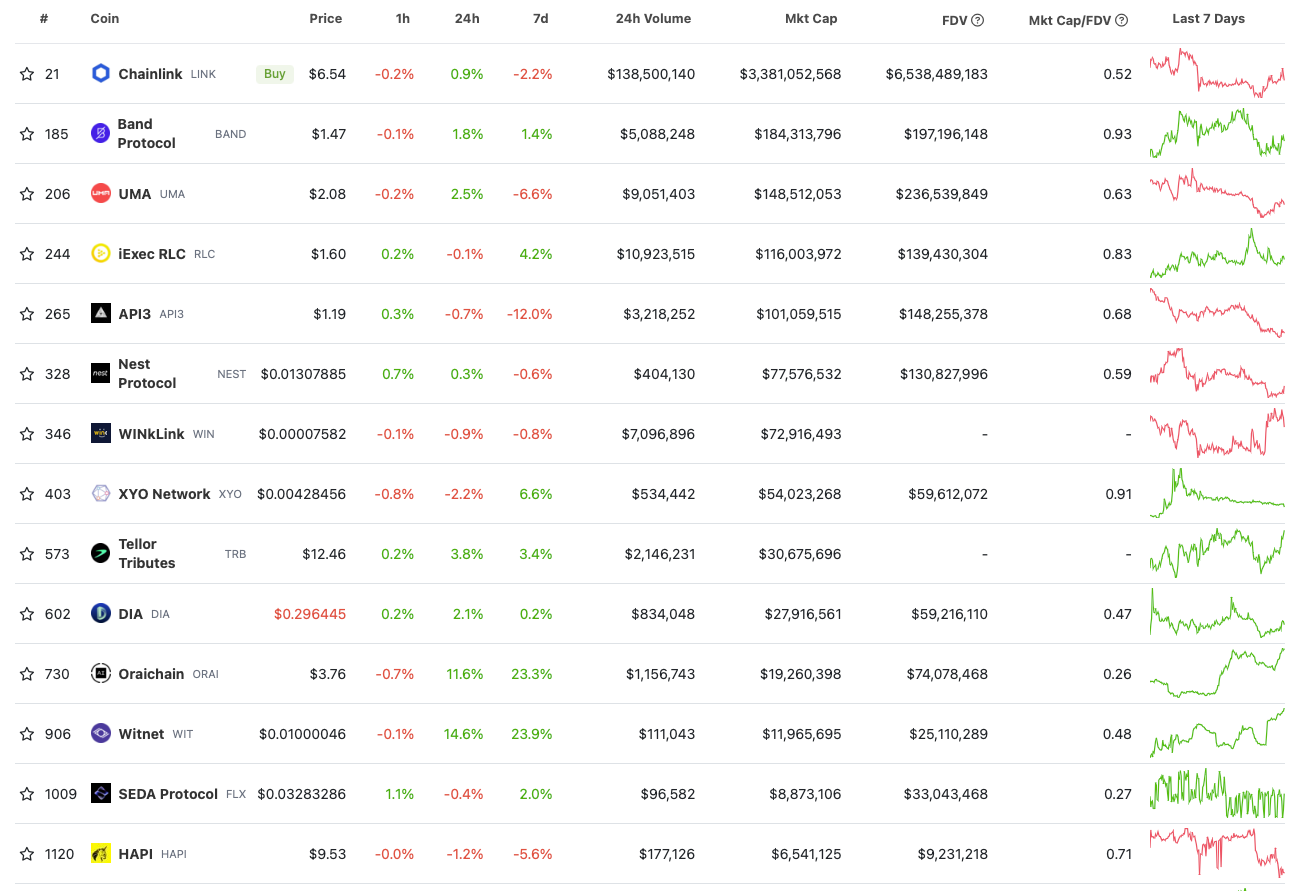
To sum up, we believe that oracle machines, especially the vertical oracle machine category on the segmented track, can still be regarded as an investment direction worthy of attention in the medium and long term.
Interpreting the oracle
secondary title
1.1 Concept
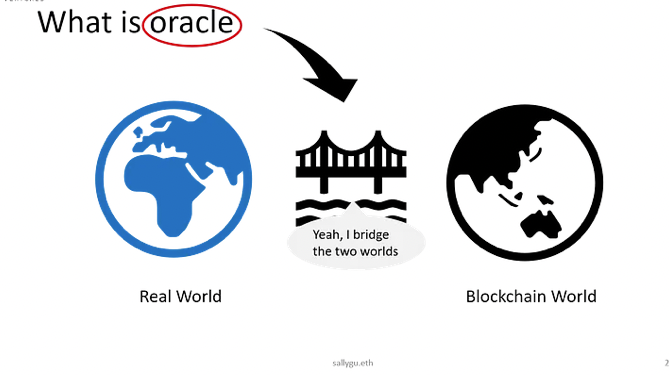
The oracle is generally regarded as a bridge connecting data on and off the chain. In short, an oracle is a middleware that provides trustworthy off-chain data services for blockchain projects.The biggest reason we need oracles is that the trust generated by the current blockchain itself is stillInsufficient to support all the needs of upper-level applications,
So more trust needs to be injected into the oracle machine:• Currently, the amount of data off-chain and on-chain is still unequal. Compared with the off-chain real world with rich data types and huge data volume,
The amount of data in the world on the chain is far from enough to support its independent development completely away from the chain. Most of the current protocols cannot survive without access to oracles.• This is why many people say that oracles are
"necessary evil necessary evil". When one day the richness of the data on the chain surpasses that of the off-chain and becomes thick enough, we no longer need to rely on oracle machines or similar relay agents. This is why many DEX and DeFi protocols are very obsessed with oracleless The root cause of the native design on the chain.
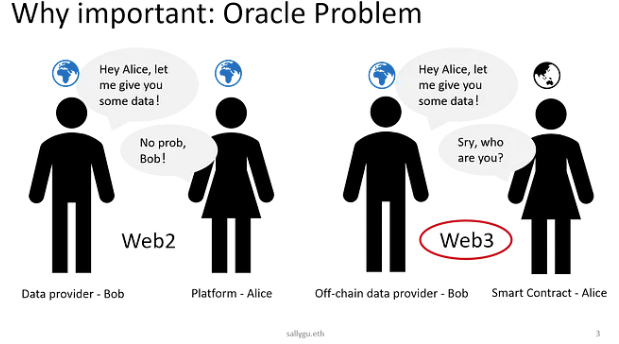
The blockchain is a closed system that cannot be directly connected to the Internet. Smart contracts cannot directly access deterministic information from the Internet and the real world, including stock prices, exchange rates, the final results of the presidential election, etc., and the consensus mechanism also requires credible A third party verifies the data. Therefore, the oracle plays more like a broker role that matches trust on and off the chain.It is worth pointing out that the key problems solved by the oracle here are:Not how to get information from the real world(In fact, anyone, you and me, can upload the data off the chain to the chain), butHow to help the blockchain trust information from the real world
(Even if you and I pass the data off the chain to the chain, it is useless, no one will believe it, and no one will adopt it. Of course, the problem of honest nodes is also involved here).It is communication, not just connection, that generates trust.Therefore, the intrinsic value of the oracle machine depends on its opening up the communication channels on and off the chain, that is, throughForwarding, Validation and Filtering"How much is trustworthy".
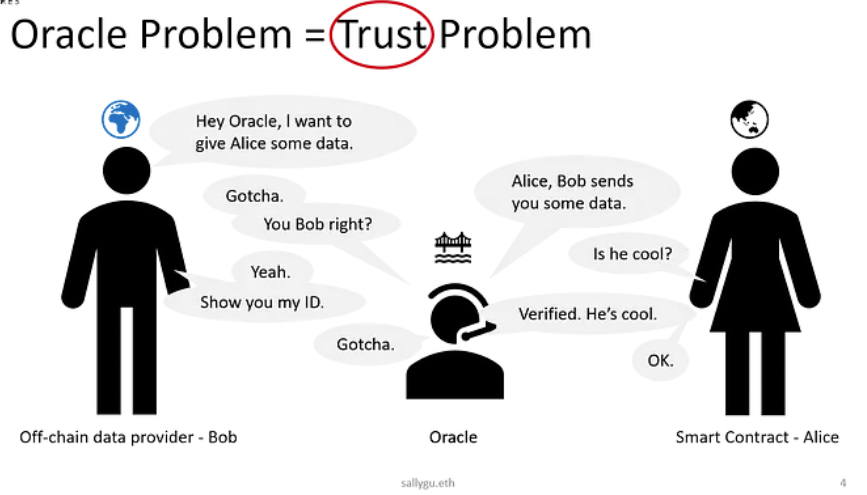
secondary title
1.2 Classification
According to the form, we can divide it into software oracle machine and hardware oracle machine according to the form of oracle machine:• Software oracles:
Provide API/SDK and other services to help the protocol access and transmit third-party server data, such as commodity prices, weather indexes, flight numbers, etc.• Hardware oracles:
Hardware oracles are widely used in IoT, such as electronic sensors and data collectors.
According to the data source, it can be divided into centralized oracle machine and decentralized oracle machine:• Centralized oracles:
Usually only a single trusted third party such as government departments, official institutions, reputable companies, etc. provides data. Its advantage is that it can separate data from the untrusted operating system of the local device, preventing data tampering and loss. The disadvantage is that a single centralized data brings the risk of a single point of failure.• Decentralized oracles:
A decentralized oracle refers to an oracle with a distributed consensus mechanism, also known as a consensus oracle. It gets data from multiple external sources instead of a single one, so it is more reliable and trustless.
Centralization vs Decentralization
The centralized oracle machine has the advantages of high efficiency and great feasibility. Decentralized oracles are more trustworthy and secure due to their discrete multi-node and cross-referencing process.
Due to the requirements and concerns of trust risk management and control, most DeFi applications basically directly use third-party decentralized oracles such as Chainlink instead of independently building a simple centralized oracle or running nodes to transport off-chain data To the chain (re-emphasize that even if the project party or individual uploads the data to the chain by themselves, they will not be able to gain the trust of the community).
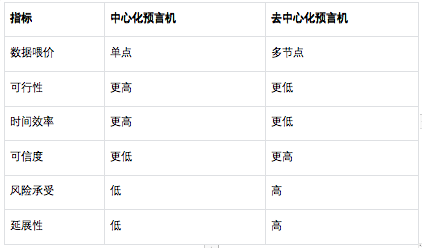
secondary title
1.3 Application scenarios2021 Chainlink 2.0 White Paper First Introducedthe concept of. DON is a network maintained by a group of Chainlink nodes, which allows Chainlink to provide external data to the blockchain through trustless off-chain calculations. In order to achieve its vision, Chainlink launched a series of products and services such as VRF, Keepers, and CCIP, which further opened up the application scenarios of oracles in web3. In the figure below, we list the application cases of oracles in several different scenarios such as DeFi, NFT, GameFi, Social, DAO, and cross-chain for reference:
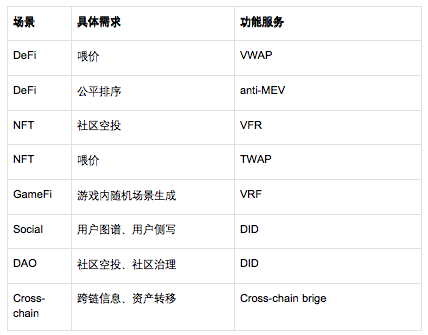
secondary title
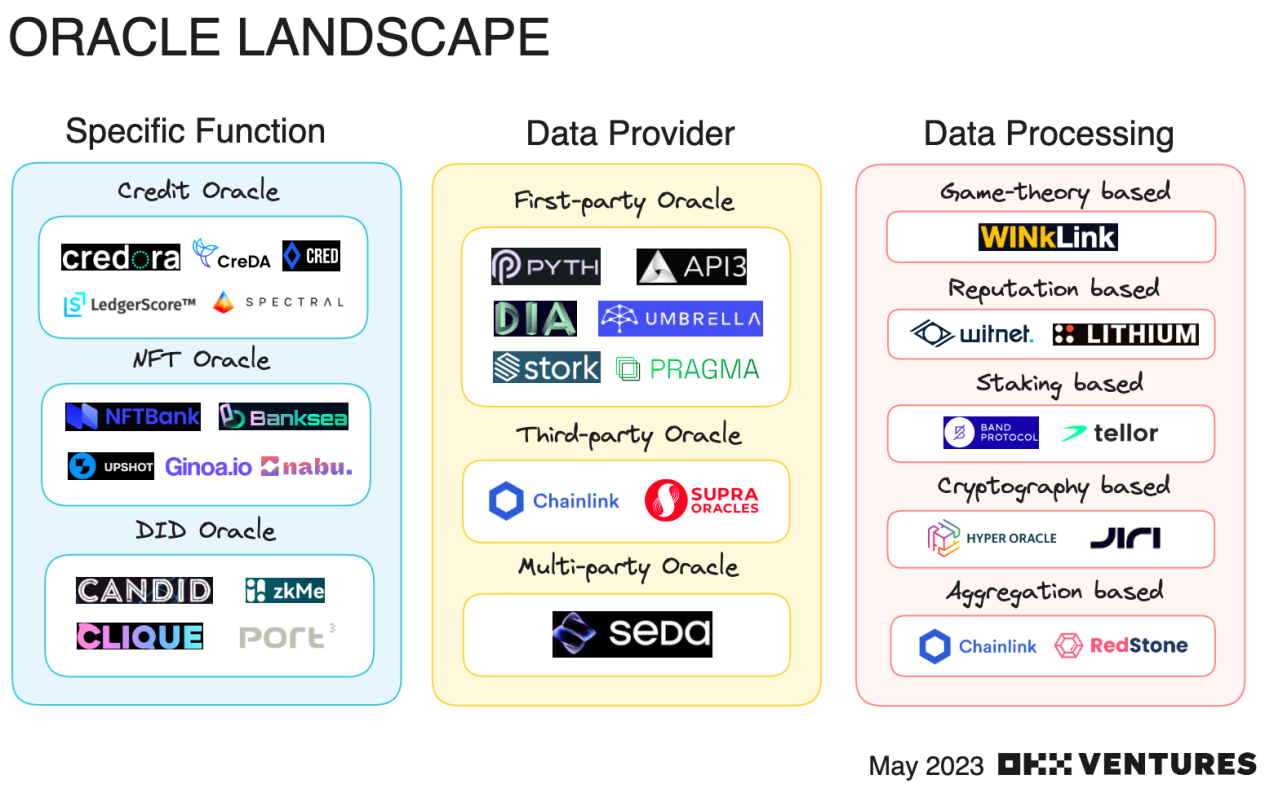
1.4 Track map
We believe that oracles can be simply classified using three dimensions:
They are based on specific functions, data sources, and data processing methods.1. According tospecific function, in addition to the common defi oracles, here are three common types:
2. According toData SourcesData Sources, can be divided into three types:
First-party oracles, third-party oracles, and multi-party oracles.3. According toData processing methodGame theory-based oracles, reputation-based oracles, staking-based oracles, cryptography-based oracles, and aggregation-based oracles.
Anticipation of Investment Opportunities
secondary title
2.1 Viewpoint
A. Traditional defi uses the oracle machine as the main data feed function. It is difficult to see who will break the chainlink monopoly (80-90% market share) in a short time. But there may still be room for second place in the remaining 10% or so of the market:
▪ ○ One is that this project has a consensus mechanism innovation, and Vitalik gave two solutions that may have theoretical landing projects in the future
Based on game theory game-theory, combined with PoS/PoW
▪ Form of DAO committee/decentralized court○ One is that there is a substantial improvement in the cost performance of functions,Price feeding or random number generation is cheaper than Chainlink,
For example, Redstone, Ontropy, etc. claim that their feeding price can be 80-100 times cheaper than traditional solutions such as Chainlink. Because generally speaking, only under the premise of greatly reducing the call cost, defi or gaming project parties may use it to replace original service providers such as chainlink out of economic benefits.
○ B. For oracle machines in subdivided fields, there are potential opportunities in several directions such as L2, credit, NFT, and DID:L2 oracleIt is mainly the native solution of op/zk two ecology,Low Latency and Security
It should be the core concern, and the low price is relatively secondary
▪ Considering the expansion progress of chainlink on various non-EVM chains, if the price feed on a certain chain is basically monopolized by chainlink, the difficulty of competition will be greatly increased.▪ L2 oracle should largely belong to derivatives exchangeshigh frequency tradingappeal (L2 is more capable of providing higher tps support and thus can support decentralized derivatives transactions on the chain), similar to pyth and empiricThe price feed is more refined or the data integration process is more robust (such as directly doing on-chain first party data integration + verification, so that no off-chain nodes are needed)
oracle protocol▪ ifThe tokenomics design is reasonable and more utilities are added
○(Chainlink's tokenomics design has been criticized for lack of utility, but LinkPool's similar liquidity staking + interest-earning agreement appeared later, which activated liquidity to a certain extent). A more stable performance.
Credit oracles combined with on-chain credit expansion theory are likely to detonate in the next cycleCreDA\Cred Protocol\LedgerScore\Spectral\Credora: Infrastructure for Institutional Credit, etc.
▪ The perfection and soundness of the credit rating system on the chain is the prerequisite for building an insurance and recovery mechanism on the chain, so it plays an important role in the development and evolution of defi. We have given several examples of credit oracles in the track map above:▪ As far as this specific subdivision direction is concerned, we believe that more attention should be paid to the differences in data verification and integration of the same type of products on the chain (theCoverage, cleaning ability and credit rating accuracy, etc.
). In addition, if the team has a strong financial engineering background or actuarial ability, it will be a good plus
▪ At the same time, we also noticed that the entire project of the off-chain credit system on the chain will be more complicated than expected:
• On the one hand, it is difficult for a single project to directly link with a certain country's social credit system. A key question may be: Can economic activities under the chain really endorse the credit capacity on the chain? However, as Spectral Finance has strong BD capabilities, it may be a good solution to directly cooperate with large US credit rating agencies.
○ • On the other hand, the barriers to uploading the credit data released under the integrated chain are not high (traditional Internet cloud teams theoretically have the ability to develop and implement related functions).NFT oracle
There are mainly two ideas:▪ One istwap time weighted average
, of course also useful moving average
• Currently, vwap cannot be realized because the trading volume is insufficient. Considering the non-liquidity and non-homogeneous nature of NFT itself, it is unlikely that we can foresee the realization of NFT vwap in a short time.
• Several traditional defi oracles such as chainlink and DIA have already provided NFT's twap price feeding service, and many of them will directly adopt chainlink's twap solution.
• After communicating with relevant technical teams, we tend to believe that most of the current NFT twap price feed functions are still in the preliminary stage, and there is room for optimization in the integration method, but overall, the development prospects in this direction are not great.▪ One isOff-chain computing with AI/ML
We think the valuation pricing plan is relatively more promising.• Some horizontal integration can be carried out in the later stage, transforming intoFull-stack NFT data analysis + purchase + evaluation
Application (flow entry and liquidity activation scheme for NFT spot) is a good potential scenario.
• However, this kind of scheme is basically a black box because the algorithm is not open source, and it is difficult to obtain the trust of cooperation agreements (such as upshot, banksea, although they have achieved good results in financing, it is difficult for the project to create a source of income or issue coins in a short period of time. , the profit depends on other derivative businesses, such as wallet data analysis and market integration service fees).• Nabu's similar open source ML may be a good transparent solution, but its future profitability is still difficult to predict. However, if a similar protocol could be transformed into aOpen source ML model DAO + coin issuance
○ , with reference to commercialization ideas such as Forta/Go+ on the security track, theoretically, there is a good room for imagination in the development prospect.DID Identity Oracle
It is to collect user off-chain data and upload it to the protocol service that requires identity verification and drawing social graphs. This subdivision field has high value in the long run.
▪ The CanDID (DECO) team under Chainlink relies on highly optimized multi-party computation and zero-knowledge proof technologies to try to create a decentralized on-chain identity infrastructure. Like legalDAO, zkDID projects such as Intuition are also providing similar solutions by designing DAO committee type authentication services.▪ However, most of the identity oracles currently seen are basicallyCentralized, with low barriers
(Although most of them intend to transform into a decentralized form in the future, it is difficult to verify its feasibility without actual implementation).▪ Also need to focus on its(such as the quality of the node, whether the verification is credible) andstorageWhat is used and how to achieve it.
secondary title
2.2 Case
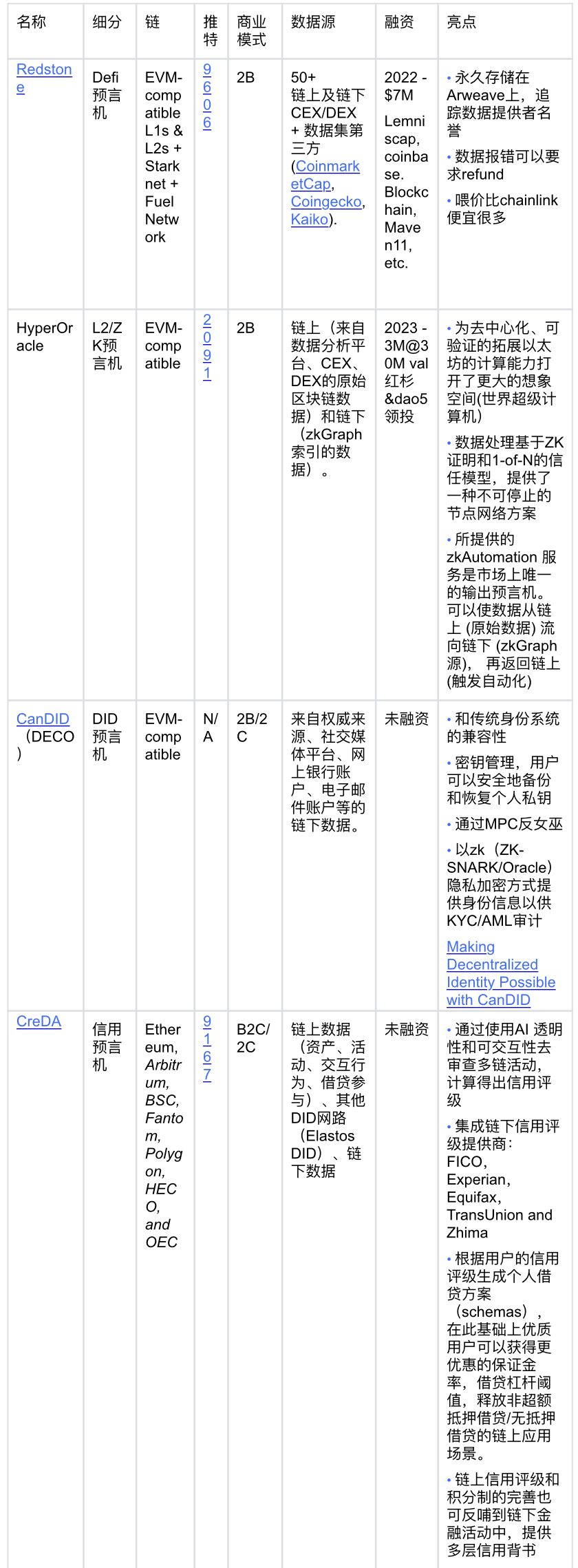
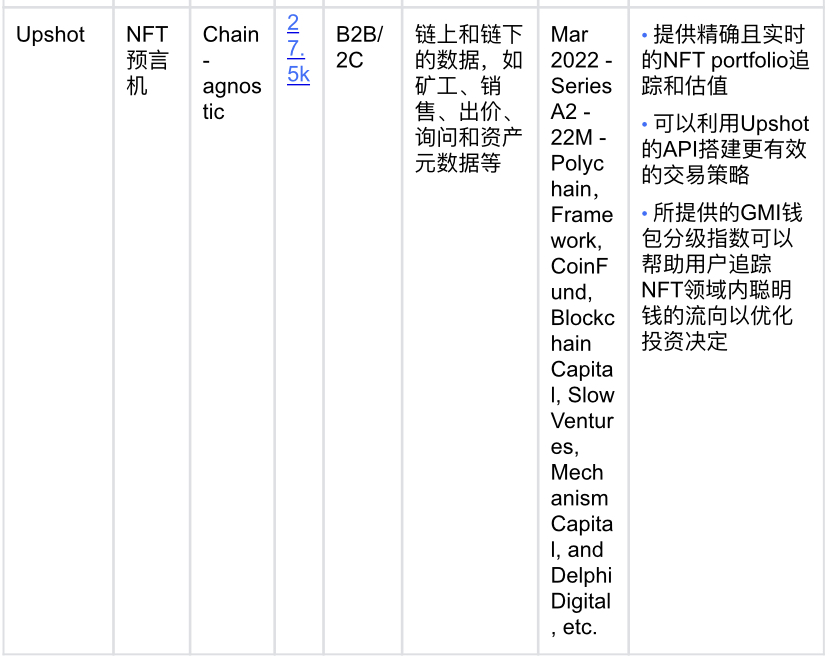
According to the investment point of view given above, we selected a case in each subdivision direction for simple analysis for reference.



